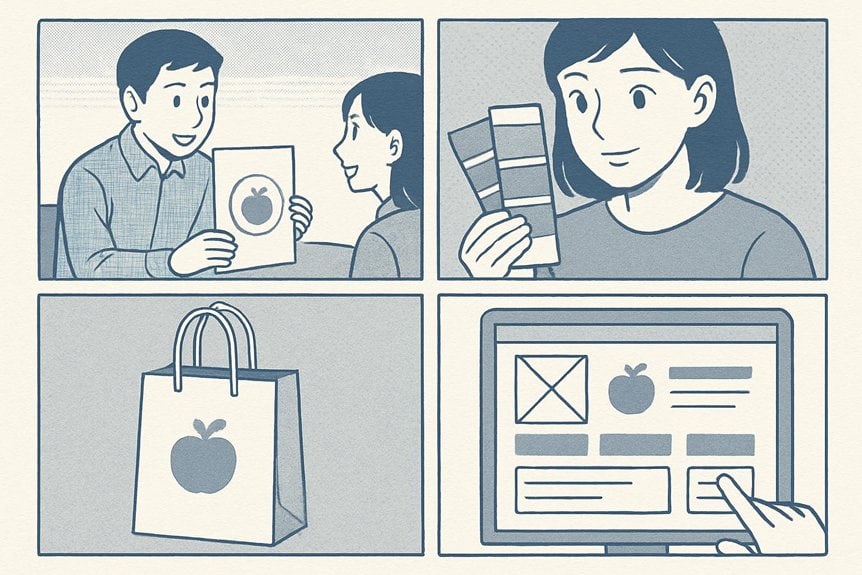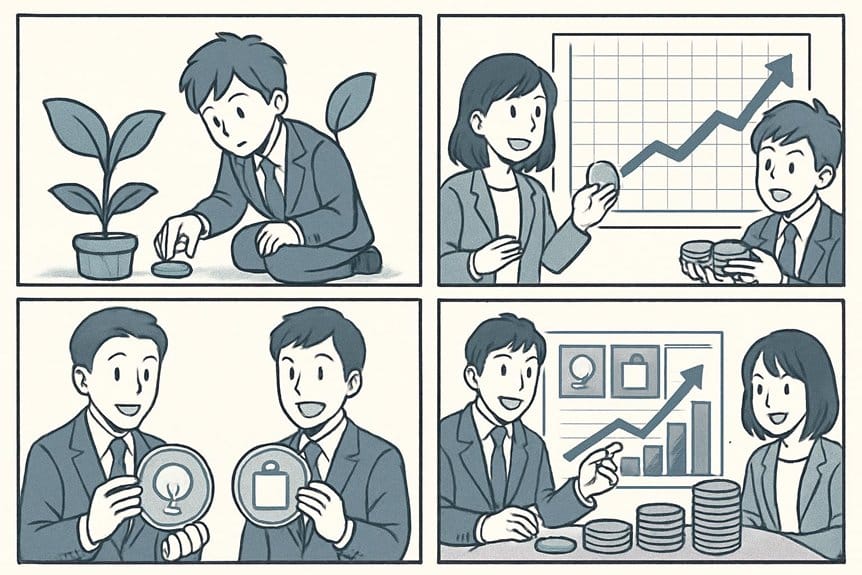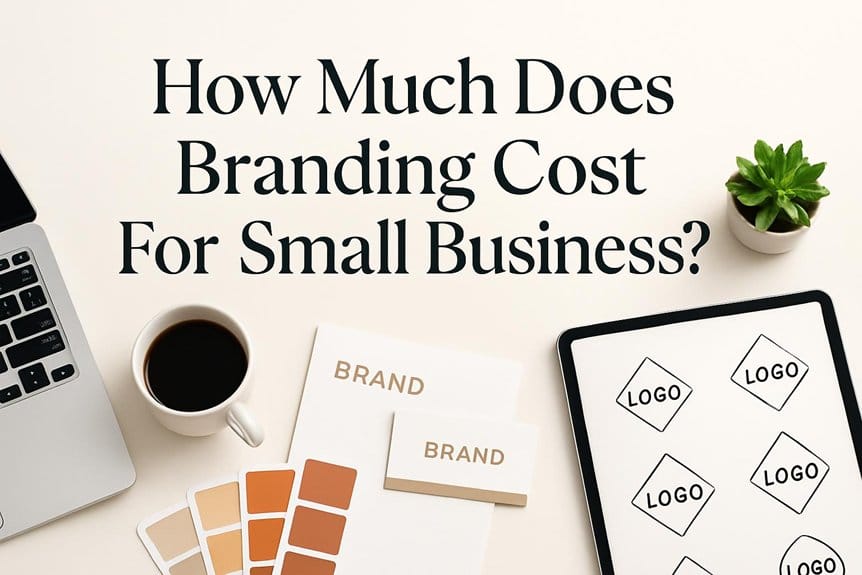Branding can cost almost nothing if you DIY templates and basic assets, or from a few hundred to a few thousand with freelancers and better files, up to $10k–$50k for a strategic identity from a studio, and $50k+ for full-agency programs. You’ll pay separately for domain, hosting, packaging, and ongoing content or ads. Prioritize clarity, templates, and measurable channels early to stretch your budget — keep going to see practical budgeting and next steps.
Key Takeaways
- Basic DIY brand (logo template, color, fonts) typically costs $0–$300 for fast, low-control results.
- Freelance-designed identity (custom logo, basic style guide) commonly runs $200–$2,000 depending on experience.
- Boutique studio packages for strategic identity and deliverables usually cost $2,000–$10,000.
- Full-agency or research-driven rebrands start at $10,000 and can exceed $50,000 for comprehensive work.
- Budget beyond design: domain/hosting ($50–$500/yr), marketing content, and ongoing maintenance vary by scope.
What Branding Actually Includes and Why It Matters

When you think of branding, don’t just picture a logo — it’s the combination of your visual identity, voice, customer experience, and the story you tell that shapes how people perceive your business; getting these elements right builds recognition, trust, and long-term value.
Branding isn’t just a logo — it’s visual identity, voice, experience, and story that build trust and recognition.
You’ll need a clear logo, color palette, typography, and imagery that work across digital and print.
Your brand voice guides copy, social posts, and customer interactions so messaging stays consistent.
Experience design — website usability, packaging, and service touchpoints — turns promise into perception.
Strategic positioning defines who you serve and why you’re different.
Measuring perceptions and adjusting keeps the brand relevant.
Investing here reduces marketing waste and makes every customer interaction an opportunity to reinforce value.
Early-Stage Branding: DIY and Low-Cost Options
You can get a clean logo on a budget using templates or freelance marketplaces without breaking the bank.
Focus on a basic brand style—colors, fonts, and simple usage rules—to keep your look consistent.
Then create DIY brand assets like social graphics, email headers, and business cards with free or low-cost tools to start building recognition.
Logo on a Budget
Getting a logo that looks professional doesn’t have to blow your budget; with the right tools and a clear vision, you can craft a memorable mark yourself or through low-cost options.
Start by defining what your business stands for and pick one simple symbol or wordmark that communicates that idea. Use free or inexpensive logo makers and templates to iterate quickly, keeping shapes clean and scalable.
Choose two readable fonts and a limited color palette so the mark stays flexible across uses. Test the logo at small sizes and in black-and-white to guarantee legibility.
If you need a polish, hire a freelance designer for a brief refinement rather than a full redesign. Save originals and document usage rules for consistency.
Basic Brand Style
Because a consistent style turns a rough logo into a recognizable brand, start by defining a small set of visual rules you can actually use every day. You’ll save time and look more professional across social posts, invoices, and signage.
Focus on a few parameters and stick to them so your audience learns to recognize you.
- Color palette: pick 2–3 primary colors and 1 neutral for backgrounds.
- Typography: choose one heading font and one body font (or web-safe alternatives).
- Logo usage: set minimum size, clear space, and allowed color variations.
- Imagery style: decide on photo filters, illustrations, or icons and keep them consistent.
Document these rules in a single page you can reference and share.
DIY Brand Assets
While you’re still small on budget, you can create effective brand assets yourself by focusing on practical, repeatable tools and templates you’ll actually use.
Start with a simple logo — sketch ideas, refine one in a free vector editor, and export clear versions for web and print.
Build a basic color palette (primary, secondary, neutral) and save hex codes.
Choose two fonts: one for headings, one for body, and store license info.
Create templates for business cards, email signatures, social posts, and a one-page media sheet so your visuals stay consistent.
Use free or low-cost tools (Canva, Figma, Google Workspace) and keep editable masters.
As you grow, these DIY assets make upgrading smoother and cheaper.
Logo and Visual Identity: Price Ranges and Choices
You’re starting with a logo and visual identity that’ll represent everything your small business stands for, so you need to know what options exist and how much they typically cost. You can choose a quick DIY mark, a freelance designer, a boutique studio, or a full agency package — each gives different quality, files, and rights.
- DIY tools: $0–$100 — templates, low control, limited file types.
- Freelance designer: $200–$2,000 — custom concepts, better files, variable revisions.
- Boutique studio: $2,000–$10,000 — strategic design, thorough deliverables, stronger brand cohesion.
- Agency: $10,000+ — research, full visual system, scalable assets, ongoing support.
Pick based on budget, timeline, and how central identity is to growth; request clear deliverables and ownership.
Brand Messaging and Voice: Costs and Must-Have Deliverables

If you want customers to understand and remember your business, start by defining a clear brand voice and core messages that guide every touchpoint—from your tagline and website copy to emails and social posts.
You’ll invest in a messaging workshop ($500–$3,000) to align positioning, value props, and audience tone. Deliverables should include a messaging framework, 3–5 core messages, elevator pitch, tagline options, and voice guidelines with dos and don’ts.
You might add sample email and social post templates or a content style sheet ($200–$1,000 extra). Freelance writers or consultants charge variably; agencies cost more but give strategy plus execution.
These assets save time, guarantee consistency, and make future content creation far easier and faster.
Website and Domain: Budgeting for an Online Home
You’ll need to budget for a domain name, which can range from a few dollars a year to premium prices for short or popular names.
Decide whether you’ll use a template site builder, a custom designer, or a developer — each option has different upfront and ongoing costs.
Don’t forget hosting and maintenance fees for security, backups, and occasional updates.
Domain Name Costs
Before you launch your site, decide what domain name fits your brand and budget—it’s the address customers type, remember, not just a label.
You’ll pay for choice, renewal, and sometimes transfer fees.
Plain .coms cost $10–$20/year; specialty TLDs (like .shop) can be $20–$60/year or more.
Premium names sold on marketplaces may run hundreds to thousands upfront.
Factor privacy protection (~$5–$15/year), and occasional broker or auction charges if you pursue a taken name.
- Register: typical annual fee, $10–$60.
- Renewals: plan for yearly billing; prices can rise.
- Privacy: optional add-on to hide contact details.
- Premium/transfer: one-time higher cost for sought-after names.
Website Design Options
While choosing how your site will look and work, weigh cost against control and speed to launch—template builders get you online fast and cheap, while custom design gives unique branding but costs more and takes longer.
You can use drag-and-drop platforms (Wix, Squarespace, Shopify) to save on design fees and get responsive templates, built-in SEO, and ecommerce basics.
If you need a particular interaction, brand story, or conversion-focused layout, hire a freelance designer or agency for a bespoke site; expect higher upfront fees and a longer timeline.
Consider hybrid approaches: buy a premium theme and pay a developer to customize it.
Factor in mobile-first design, accessibility, and scalable layouts so your site represents your brand as it grows.
Hosting and Maintenance
Pick a reliable hosting plan and domain registrar early, because they determine your site’s uptime, speed, security, and recurring costs.
You’ll pay for hosting (shared, VPS, or dedicated) and renew your domain yearly; choose providers with backups, SSL, and good support to avoid surprise expenses.
Factor maintenance: software updates, plugin licenses, content edits, and occasional developer time for fixes or improvements.
- Hosting type: shared (low), VPS (mid), dedicated/cloud (higher)
- Domain: registration + privacy protection (annual)
- Security & backups: SSL, monitoring, automated backups
- Maintenance hourly or retainer: updates, content, troubleshooting
Budget a small monthly amount for hosting and a buffer for occasional developer hours to keep your site healthy.
Print Materials and Packaging: When to Invest Upfront
When you decide which print materials and packaging to invest in upfront, focus on the pieces that directly shape customers’ first impressions and repeat purchases—like logoed packaging, business cards for networking events, and a clear product label that meets legal requirements. You’ll prioritize items that protect product integrity, convey brand quality, and reduce friction at checkout or unboxing. Start small: essential labels, minimal packaging, and a versatile business card. Scale printed collateral as orders and margins grow. Track cost per unit, durability, and supplier minimums so you don’t overcommit.
| Item | When to Buy |
|---|---|
| Product labels | Before first sale |
| Primary packaging | When shipping starts |
| Business cards | Before events |
| Instruction inserts | With first batch |
| Promotional flyers | After local traction |
Hiring Designers and Agencies: What to Expect to Pay

If you need professional help shaping your brand, expect a wide price range depending on scope and experience: freelance designers can charge $30–$150 per hour or $200–$2,000 for small projects, while agencies often bill $5,000–$50,000+ for full identities and strategy.
You’ll pick freelancers for logo tweaks, basic identity kits, or quick turnarounds; choose an agency when you need research, positioning, and cohesive systems. Ask for clear deliverables, timelines, revisions, and file ownership. Get quotes from multiple providers and check portfolios, references, and case studies.
- Freelance logo/basic kit: $200–$2,000
- Mid-range freelance/full identity: $1,000–$10,000
- Small agency: $5,000–$20,000
- Strategic agency/rebrand: $20,000–$100,000+
Ongoing Marketing and Brand Maintenance Costs
Because a brand isn’t a one-time purchase, you’ll need to budget for ongoing marketing and maintenance to keep it visible and relevant. Expect monthly and annual costs: content creation (blogs, social, video), paid ads, email marketing tools, SEO work, and occasional campaign creative.
Factor in website hosting, updates, and security, plus analytics subscriptions and A/B testing. Don’t forget reputation management — reviews, PR outreach, and customer service training — and periodic asset refreshes like imagery, templates, or packaging tweaks.
You can lower expenses by batching content, using freelancers, and automating workflows, but allocate a steady percentage of revenue or a fixed monthly amount so marketing stays consistent. Regular investment prevents brand decay and sustains growth.
How to Prioritize Branding Spend by Growth Stage

As you move through different growth stages, prioritize branding spend to match the goals and resources of each phase: invest in core identity and foundational assets early, shift toward customer acquisition and experience as you scale, and focus on retention and brand defense at maturity.
You’ll allocate differently depending on stage and risk tolerance.
Early-stage choices favor clarity and flexibility; mid-stage budgets tilt to consistent messaging and scalable channels; mature brands protect equity and optimize lifetime value.
Use this simple spending framework to guide decisions:
- Startup: logo, name, simple website, basic messaging.
- Growth: consistent visual system, content, paid acquisition tests.
- Expansion: advanced UX, integrated campaigns, PR.
- Maturity: loyalty programs, reputation management, brand legal protection.
Cost-Saving Tips and Tools to Stretch Your Branding Budget
Stretch your budget by choosing tools and tactics that deliver the most brand impact per dollar, and focus on high-impact actions you can control.
Start with a simple brand kit—logo variations, color palette, and typography—created with affordable freelancers or DIY platforms to maintain consistency.
Use templates for social posts, email, and proposals to save design time.
Automate posting and analytics with low-cost tools so you can iterate based on performance, not guesswork.
Repurpose content across formats: blog posts become social snippets, emails, and short videos.
Utilize customer reviews and user-generated content as free social proof.
Barter services with complementary local businesses, and track ROI for each activity so you can cut what’s underperforming and reinvest in winners.
Frequently Asked Questions
How Do Branding Costs Differ by Industry or Niche?
They vary a lot: you’ll pay more in competitive, design-driven industries (tech, fashion) for premium identity and assets, less in local services; regulated or niche markets add research/legal costs, while volume of deliverables raises prices.
Can I Recover Branding Costs Through Taxes or Write-Offs?
Yes — you can often deduct branding expenses as ordinary business marketing or advertising costs. Keep receipts, track expenses, and consult a tax pro for classification; some logo, website, and promotional costs may require capitalization and amortization.
How Long Does It Take for Branding to Show ROI?
You’ll often see initial branding ROI in 3–6 months through increased leads and engagement, but meaningful returns usually take 6–18 months as awareness, trust, and sales compound; track metrics and iterate to accelerate results.
Should I Trademark My Logo and How Much Does That Cost?
Think of your logo as a lighthouse—yes, you should trademark it. It typically costs $225–$400 per class in the U.S. USPTO filing, plus attorney fees if you want stronger protection and fewer headaches.
Can I Sell or Transfer My Brand Assets if I Sell the Business?
Yes — you can sell or transfer brand assets when you sell your business, but you’ll need clear written assignments, licensing or sale agreements, and to address trademarks, copyrights, and contracts so ownership transfers cleanly and enforceably.
Conclusion
Branding doesn’t have to break the bank — you can get a solid start with smart choices and phased spending. Even if you think you’re “too small” to invest, remember basic identity, messaging, and a simple website pay off fast in credibility and customer trust. Prioritize what converts, use affordable tools, and scale design work as you grow. Start now; a modest, focused brand will attract customers and save you money later.

